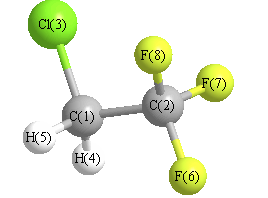Vibrational Frequencies calculated at HF/6-311G*
| Mode Number |
Symmetry |
Frequency
(cm-1) |
Scaled Frequency
(cm-1) |
IR Intensities
(km mol-1) |
Raman Act
(Å4/u) |
Dep P |
Dep U |
|---|
| 1 |
A' |
3290 |
2976 |
14.84 |
|
|
|
| 2 |
A' |
1614 |
1460 |
30.16 |
|
|
|
| 3 |
A' |
1519 |
1374 |
72.06 |
|
|
|
| 4 |
A' |
1421 |
1285 |
190.06 |
|
|
|
| 5 |
A' |
1314 |
1188 |
328.39 |
|
|
|
| 6 |
A' |
936 |
847 |
25.06 |
|
|
|
| 7 |
A' |
861 |
779 |
44.17 |
|
|
|
| 8 |
A' |
698 |
631 |
37.85 |
|
|
|
| 9 |
A' |
586 |
530 |
10.02 |
|
|
|
| 10 |
A' |
388 |
350 |
0.36 |
|
|
|
| 11 |
A' |
201 |
182 |
2.22 |
|
|
|
| 12 |
A" |
3357 |
3036 |
2.47 |
|
|
|
| 13 |
A" |
1458 |
1318 |
209.14 |
|
|
|
| 14 |
A" |
1256 |
1136 |
125.59 |
|
|
|
| 15 |
A" |
1008 |
912 |
10.38 |
|
|
|
| 16 |
A" |
587 |
531 |
3.62 |
|
|
|
| 17 |
A" |
381 |
344 |
1.09 |
|
|
|
| 18 |
A" |
108 |
98 |
4.23 |
|
|
|
Unscaled Zero Point Vibrational Energy (zpe) 10491.0 cm
-1
Scaled (by 0.9044) Zero Point Vibrational Energy (zpe) 9488.0 cm
-1
See section
III.C.1 List or set vibrational scaling factors
to change the scale factors used here.
See section
III.C.2
Calculate a vibrational scaling factor for a given set of molecules
to determine the least squares best scaling factor.
Charges, Dipole, Quadrupole and Polarizability
Charges from optimized geometry at HF/6-311G*
Charges (e)
| Number |
Element |
Mulliken |
CHELPG |
AIM |
ESP |
| 1 |
C |
-0.581 |
|
|
|
| 2 |
C |
0.889 |
|
|
|
| 3 |
Cl |
-0.069 |
|
|
|
| 4 |
H |
0.286 |
|
|
|
| 5 |
H |
0.286 |
|
|
|
| 6 |
F |
-0.281 |
|
|
|
| 7 |
F |
-0.264 |
|
|
|
| 8 |
F |
-0.264 |
|
|
|
Electric dipole moments
Electric dipole components in Debye
(What's a Debye? See section
VII.A.3)
| |
x |
y |
z |
Total |
| |
-1.320 |
1.670 |
0.000 |
2.129 |
| CHELPG |
|
|
|
|
| AIM |
|
|
|
|
| ESP |
|
|
|
|
Electric Quadrupole moment
Quadrupole components in D Å
| Primitive |
|---|
| | x | y | z |
|---|
| x |
-41.622 |
-2.896 |
0.000 |
| y |
-2.896 |
-40.448 |
0.000 |
| z |
0.000 |
0.000 |
-40.090 |
|
| Traceless |
|---|
| | x | y | z |
|---|
| x |
-1.353 |
-2.896 |
0.000 |
| y |
-2.896 |
0.408 |
0.000 |
| z |
0.000 |
0.000 |
0.945 |
|
| Polar |
|---|
| 3z2-r2 | 1.889 |
|---|
| x2-y2 | -1.174 |
|---|
| xy | -2.896 |
|---|
| xz | 0.000 |
|---|
| yz | 0.000 |
|---|
|
Polarizabilities
Components of the polarizability tensor.
Units are
Å
3 (Angstrom cubed)
Change units.
| |
x |
y |
z |
| x |
4.182 |
0.921 |
0.000 |
| y |
0.921 |
5.263 |
0.000 |
| z |
0.000 |
0.000 |
3.570 |
<r2> (average value of r
2) Å
2
| <r2> |
186.038 |
| (<r2>)1/2 |
13.640 |
